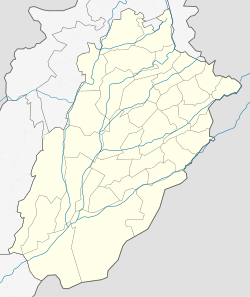Multan, Punjab
|
Multan مُلتان |
|
|---|---|
| Metropolis | |

Clockwise from the top: Tomb of Shah Rukn-e-Alam, the Shrine of Baha-ud-din Zakariya, the Shahi Eid Gah Mosque, and Multan's Ghanta Ghar
|
|
| Location in Pakistan | |
| Coordinates: 30°11′52″N 71°28′11″E / 30.19778°N 71.46972°ECoordinates: 30°11′52″N 71°28′11″E / 30.19778°N 71.46972°E | |
| Country | Pakistan |
| Region | Punjab |
| District | Multan District |
| Autonomous towns | 6 |
| Union councils | 4 |
| Area | |
| • Metropolis | 781 km2 (302 sq mi) |
| Elevation | 122 m (400 ft) |
| Population (2015) | |
| • Metropolis | 3,117,000 |
| • Urban | 2,050,000 |
| Languages | |
| Time zone | PST (UTC+5) |
| Area code(s) | 061 |
| Website | www |
Multan (Punjabi and Urdu: مُلتان) (![]() pronunciation ), is a Pakistani city located in Punjab province. Multan is Pakistan's 5th most populous city, and is the premier-centre for southern Punjab province. Multan is located on the banks of the Chenab River, and is at the heart of Pakistan's Seraiki-speaking regions.
pronunciation ), is a Pakistani city located in Punjab province. Multan is Pakistan's 5th most populous city, and is the premier-centre for southern Punjab province. Multan is located on the banks of the Chenab River, and is at the heart of Pakistan's Seraiki-speaking regions.
Multan's history stretches back into antiquity. The ancient city was site of the renowned Multan Sun Temple, and was besieged by Alexander the Great during the Mallian Campaign. Multan was one of the most important trading centres of medieval Islamic India, and attracted a multitude of Sufi mystics in the 11th and 12th centuries, earning the city the nickname City of Saints. The city, along with the nearby city of Uch, is renowned for its large collection of Sufi shrines dating from that era.
...
Wikipedia


